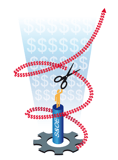The Long Game vs. The Short: Integrating S&OE and S&OP
Nick Ostdick - May 16, 2017

To understand where S&OE (sales and operations execution) and S&OP (sales and operations planning) differ, let’s think about the game of golf. During a round of golf, you have to engage in two very different approaches to the game: the long game and the short game. The long game revolves around teeing off and how close or strategically you can position yourself with your first stroke. The short game, on the other hand, concerns how you engage each hole the closer you get to the green. While the long game requires strength and agility, the short game necessitates precision and discipline. Each approach, though fundamentally different, work hand-in-hand as a player works to drop the ball in the hole with the fewest strokes possible.
The difference between the long game and the short game is essentially the difference between S&OP and S&OE in today’s global manufacturing and supply chain. S&OP allows manufacturing companies to create integrated demand planning between sales and production teams for the short to mid-term (the long game) while S&OE gives planners and managers the capacity to examine their supply situation on a more micro level (the short game).
When working synergistically, S&OP and S&OE provide companies with an enhanced level of agility, transparency, and responsiveness in each aspect of the planning process in the short, near, and long-term.
While S&OE and S&OP contain some important differences manufacturing companies must understand to effectively leverage the advantages of each strategy, the real value proposition comes from integrating S&OE and S&OP into a unified platform. With this in mind, let’s examine the definitions of S&OE and S&OP and how companies fully realize the potential of each to enhance their operations.
Defining S&OE
So, if S&OE is understood as the short game in our analogy between golf and global supply chain management, how do we concretely define this concept in the context of manufacturing and supply chain logistics? S&OE comes is something of a ultra-zoom feature on the camera for close inspection of weekly supply chain planning practices which can also be a key indicator as to the viability of S&OP or annual planning. Essentially, S&OE functions as a quick, short-term snapshot of the overall supply chain situation for planners and managers to make vital course corrections on a weekly basis to better create long-term strategies. In addition, whereas S&OP and annual planning often deal in forecasting, simulations, and other hypothetical supply and production scenarios, S&OE tracks actual demand and production metrics in real-time for a more accurate picture of the demand and production stages.
By monitoring actual demand and production data via real line items and data, S&OE provides planners and managers an early warning system that helps ensure smooth production cycles in the mid and long-term. This also allows planners and managers to avoid costly bottlenecks or production breakdowns in the mid-range future by combatting issues today that could snowball tomorrow and beyond.
S&OP defined
The purpose of S&OP is to look ahead by several months - or, playing the long game, thinking back to our golf analogy. The time frame may vary by industry, but it's usually three to 18 months. S&OP leadership works within the framework of long-term business goals, aligning its objectives accordingly. Meanwhile, S&OP also provides crucial information for setting those long-term goals because the supply chain has such impact on operational costs and profitability. The S&OP process, then, is integral to effective business planning, both in the long term and shorter term.
S&OP software solutions not only automate data mining and reporting for immediate analysis and distribution to those throughout the manufacturing and supply stream, but these systems also centralize data entry and reporting points; reduce waste in time and resources associated with manually gathering and compiling data; and allow for real-time reporting to help manufacturing and supply managers make in-the-moment, cost-effective decisions from inventory to retail settings.
In essence, a well-conceived S&OP strategy and solution makes it easy for the left hand to talk to the right, and for those within the supply network to review and analyze such potential pain points as pricing and cost data, marketing plans, financial targets, and more.
Integrating S&OE and S&OP
While it’s easy to simply compare and contrast S&OP and S&OE to highlight the ways in which planners and managers can leverage each platform independently from each other, the more interesting and valuable question is how can manufacturing companies integrate these concepts to draw greater combined value? How should companies combine S&OE and S&OP strategy to leverage more efficiency and productivity rather than deploying each platform on its own? The following steps will help your S&OP team successfully move toward this new model.
Establish an S&OE process that supports the S&OP cycle. This usually doesn't require starting from scratch. Examine your current S&OP cycle and identify all the activities that should fall under the S&OE umbrella. Any activities dedicated to the next zero to three months should immediately be moved to S&OE. The S&OE list should include demand planning tasks like tracking daily orders against monthly totals, along with comparable tasks on the supply side.
Determine a frequency for S&OE leadership meetings that supports and encourages operational execution decisions. Most supply chain leaders quickly realize that monthly S&OP meetings are not enough to manage daily operations. Instead, the S&OE team should plan to meet once each week. Consider setting this meeting at the end of the week, so the team gets an accurate view of the current week, while still able to make corrections for the immediate future as needed. Treat these meetings as a forum where S&OE leaders can address short-term concerns, and where other business leaders can come to obtain a snapshot of what's happening on the supply chain.
Synchronize S&OE with long-term business planning. One key benefit of removing S&OE from S&OP is that then both activities can contribute to strategic business planning, but only if timing is right. Once you've created an S&OE schedule, use long-term planning meetings to set your S&OP meeting schedule. Led by finance, long-term planning meetings often occur at the beginning of the month. Work backwards from these dates to set S&OP meetings, so that you can show up prepared to provide actionable S&OP insights and data. This will raise visibility of the supply chain and — always important in the age of Industry 4.0 — foster more strategic alignment across company functions.
If you want to learn more, download your guide to Transformation of Manufacturing Processes.
In this Guide you will learn:
-
Emerging Challenges in the Modern Truck/Automotive Industry
-
How Can Global Companies Adapt to These New Realities
-
How Decentralized Digital Systems Power Smarter Planning Processes
-
How flexis Can Support Flexible Supply Chain Transformation
LATEST POSTS
- Understand Circular Economy in The Manufacturing Industry
- How Can Industry 4.0 IT Integration Be Achieved Smoothly?
- The Significance of Order Sequencing in Discrete Manufacturing
- How to improve your Supply Chain Management: The Power of Control Towers
- Optimizing Human Resource Scheduling in Manufacturing: A Technological Approach



